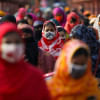Are individual districts falling behind, while Bangladesh develops as a whole?

Despite impressive gains in various development indicators compared to other developing countries, individual regions within Bangladesh are not faring as well as the country as a whole. Before delving into the details, allow us to provide some background.
After gaining independence in 1971, Bangladesh outperformed many other developing countries in two distinct ways. First, within a remarkably short period, the fertility rate plummeted from 6.9 in 1971 to 3.1 in 2001. In other words, within a single generation, Bangladesh managed to halve its fertility rate, a feat that took English-speaking and northwestern European countries over 100 years to achieve. We owe this impressive achievement to the efforts of NGOs, donor countries, and the government, accomplished within a constrained financial environment. The only other country to demonstrate a comparable rate of reduction was Japan, but it must be noted that Japan was in significantly better financial and physical conditions than post-war Bangladesh.
Second, despite Bangladesh's lower per capita income compared to India and Pakistan post-independence, it has achieved better social development outcomes in education, health, demographic factors, and gender equality since 1980. An essay published by The Economist in 2012 showed that Bangladesh outperformed India and Pakistan in every development indicator. The development literature has dubbed this unexpected combination of higher social development and lower income level as the "Bangladesh conundrum" or "development surprise." Recently, one of us asked our students to update this development narrative with more recent data. We found that between 2011 and 2021, Bangladesh's per capita income exceeded that of Pakistan, and Bangladesh still outperforms India and Pakistan in most development indicators.
So there is no doubt that the country as a whole has shown remarkable progress in development within a short period of time, despite many unique challenges post-independence. However, overall progress can conceal significant details regarding regional variations in development. A question thus arises: have the gains in development outcomes been distributed equally across all regions of the country?
Renowned economist Arthur Lewis famously stated that "development must be inegalitarian because it does not start in every part of the economy at the same time." Has this been the case for Bangladesh as well?
In a new research paper, we tackle this question for the 64 districts using per capita income data for years 2000 and 2016-17. Since district-level income data is not published in Bangladesh, we circumvent this limitation by constructing income data from household income and expenditure surveys published by the Bangladesh Bureau of Statistics (BBS). Gauging district-level income from household incomes is not straightforward, and a great deal of care in econometrics must be applied.
Before sharing the results we found, it's important to understand the concept of income convergence. Convergence is a mathematical property, but it's widely used in economics to illustrate whether the income gap among two or more countries is converging (narrowing down) or diverging (widening) over time.
Our results reveal that, contrary to what is predicted by the neoclassical models of economic growth, poorer districts are not growing rapidly enough to eliminate their income gap with the richer districts. The speed of convergence is exceedingly slow, at only 0.4 percent, suggesting that it would take about 170 years to eliminate half of the income gap between the poorer and richer districts in Bangladesh. This result is disappointing, as one would expect poorer regions to grow quickly enough to catch up with their richer counterparts. In comparison, regions within both developed and emerging nations demonstrate a speed of convergence of two percent, suggesting that the half-life of income disparity – meaning the time it takes to halve the initial income gap – amounts to roughly 35 years, or just over a generation.
The finding of no income convergence in Bangladesh is surprising, as a unique aspect of the country's development was focused on bottom-up or broad-based development, rather than relying on trickle-down effects.
Geographical proximity does not necessarily facilitate income convergence between poorer and richer districts in Bangladesh. This surprising finding can be explained in light of the concentration of economic activities in just two districts: Dhaka and Chattogram. Without the presence of appropriate economic conditions, policies, and institutional frameworks, the benefits of geographical proximity are not uniformly realised across all districts of Bangladesh.
Recognising the considerable challenge for a poorer district like Gaibandha to eliminate the income gap with a district like Dhaka, we also examined whether poorer, middle-income, and richer districts are converging among themselves. This concept is known as "club convergence" in the economic growth literature. To our great surprise, the results were once again extremely disappointing. There was no evidence of income convergence even among the different income tiers within Bangladesh. We also employed two machine-learning routines to endogenously determine income convergence among different income groups across the country. However, we failed to find any evidence of income convergence among the districts of Bangladesh.
The finding of no income convergence in Bangladesh is surprising, as a unique aspect of the country's development was focused on bottom-up or broad-based development, rather than relying on trickle-down effects. Although our study did not investigate potential barriers to income convergence, one possibility could be that household incomes are measured with substantial errors, which in turn, complicates the task of detecting convergence. Additionally, it is possible that regional income dynamics in Bangladesh are characterised by persistent income inequality and the existence of multiple stable income levels – a situation referred to as "multiple equilibria" in economic terms. Regardless, the persistent income disparity among the districts in Bangladesh is a matter of grave concern. Further research is needed to understand the missing link between development gains and income divergence.
The unequivocal rejection of conditional convergence in income reinforces Arthur Lewis' notion that the process of economic development has been uneven among the districts of Bangladesh. In terms of policy implications, our results suggest that large-scale policy interventions may be required to invigorate the more impoverished regions of the country in the face of escalating economic disparity. Furthermore, while small-scale interventions such as microfinance are not the ultimate solution to persistent disparity, recent research emphasises that education remains the most effective pathway out of poverty and disparity in Bangladesh. To paraphrase Confucius, for the sake of 10 years' benefit, we must reinforce our social support, and for the sake of a hundred years' benefit, we must educate children.
Dr Syed Abul Basher is professor of economics at East West University (EWU), Bangladesh.
Dr Francesca Di Iorio is professor of statistics and economics at the University of Naples Federico II, Italy.

 For all latest news, follow The Daily Star's Google News channel.
For all latest news, follow The Daily Star's Google News channel. 













Comments